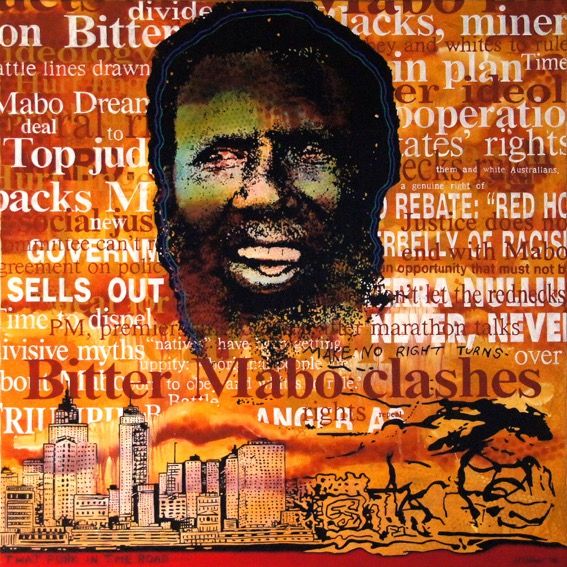We acknowledge the Traditional Owners of the land on which the Queensland Art Gallery | Gallery of Modern Art stands and recognise the creative contribution First Australians make to the art and culture of this country.

Gordon Bennett / Australia 1955–2014 / Eddie Mabo (after Mike Kelley’s ‘Booth’s Puddle’ 1985, from Plato’s Cave, Rothko’s Chapel, Lincoln’s profile) 1996 / Synthetic polymer paint on canvas / 100 x 100cm / The James C. Sourris AM Collection. Gift of James C. Sourris AM through the Queensland Art Gallery | Gallery of Modern Art Foundation 2019. Donated through the Australian Government’s Cultural Gifts Program / Collection: Queensland Art Gallery | Gallery of Modern Art / © The Estate of Gordon Bennett
Gordon BennettEddie Mabo (after Mike Kelley’s ‘Booth’s Puddle’ 1985, from Plato’s Cave, Rothko’s Chapel, Lincoln’s profile) 1996
On Display: QAG, Gallery 12
This portrait by Gordon Bennett features Eddie Koiki Mabo (1936–92), one of Australia’s most important historical figures. Mabo was a Meriam Mir man from Mer (Murray Island) in the Torres Strait, who, in 1982, along with fellow Meriam men James Rice and Doug Passi, initiated a legal case against the state of Queensland for title over their lands. Mabo was convinced that he owned his family’s traditional land on Mer, only to discover in the mid 1970s that it was annexed by the government in 1879.
In 1992, the High Court found 6 to 1 in favour of Mabo and his co-plaintiffs, overturning the accepted view that Australia had been terra nullius (uninhabited land) before white settlement. The decision lead to the Native Title Act of 1993, and permanently altered the way Australians conceive of Aboriginal land ownership.
For Gordon Bennett, who learned of his Indigenous heritage in his early teens, Eddie Mabo was a person he knew only through news reports. In making this portrait, he used a newspaper image combined with headlines generated by the Mabo case. According to Bennett: ‘To me the image of Eddie Mabo stood like the eye of a storm, calmly asserting his rights while all around him the storm, a war of words and rhetoric, raged.’
Gordon Bennett was born in 1955 in the central Queensland town of Monto. Bennett ‘discovered’ his Aboriginality at the age of eleven. The explicit imagery in his paintings concentrates on his Indigenous heritage, the Eurocentric schooling he experienced, the subjectivity of history, patriarchal knowledge systems and racism.
Bennett attended the Queensland College of Art in Brisbane and completed a Fine Arts Degree in 1988. He had already begun exhibiting his large, semi-autobiographical paintings the previous year in group exhibitions at THAT Contemporary Art Space in Brisbane and the Museum of Contemporary Art in Sydney.
From the time he graduated from art college, Bennett’s work displayed a high level of maturity and a clear sense of direction, but it also flagged his intention to resist certain expectations or categorisations of him as a particular ‘kind’ of artist. He remained uncomfortable with terms such as ‘urban’ or Aboriginal artist, for example, throughout his career, as he consistently drew on imagery and references from Indigenous and Western approaches to art, rather than a preference for one over the other.
Discussion Questions
1. Watch a video published by the School of Life that introduces and explains the allegory of Plato’s Cave. What parallel is Bennett drawing between Eddie Mabo and Plato’s Cave?
2. Look up Mer Island on Google maps. Set your view to satellite. Compare the outline of Eddie Mabo’s portrait in Bennett’s painting with the shape of Mer Island.
3. The Mabo case for native title is a landmark case. What does that mean? Consider the double meaning of the term in relation to this case.
Activities
Stand with a light behind you facing a sheet of paper tapped to a wall. Draw the outline of the silhouette cast by the shadow of your head. Within the silhouette draw a portrait of someone who has patiently taught you a complicated lesson. Illustratively fill the negative space surrounding your outline with words and phrases about that person. Connect with the person you drew or someone else that they may have taught and ask them about their knowledge of native title.